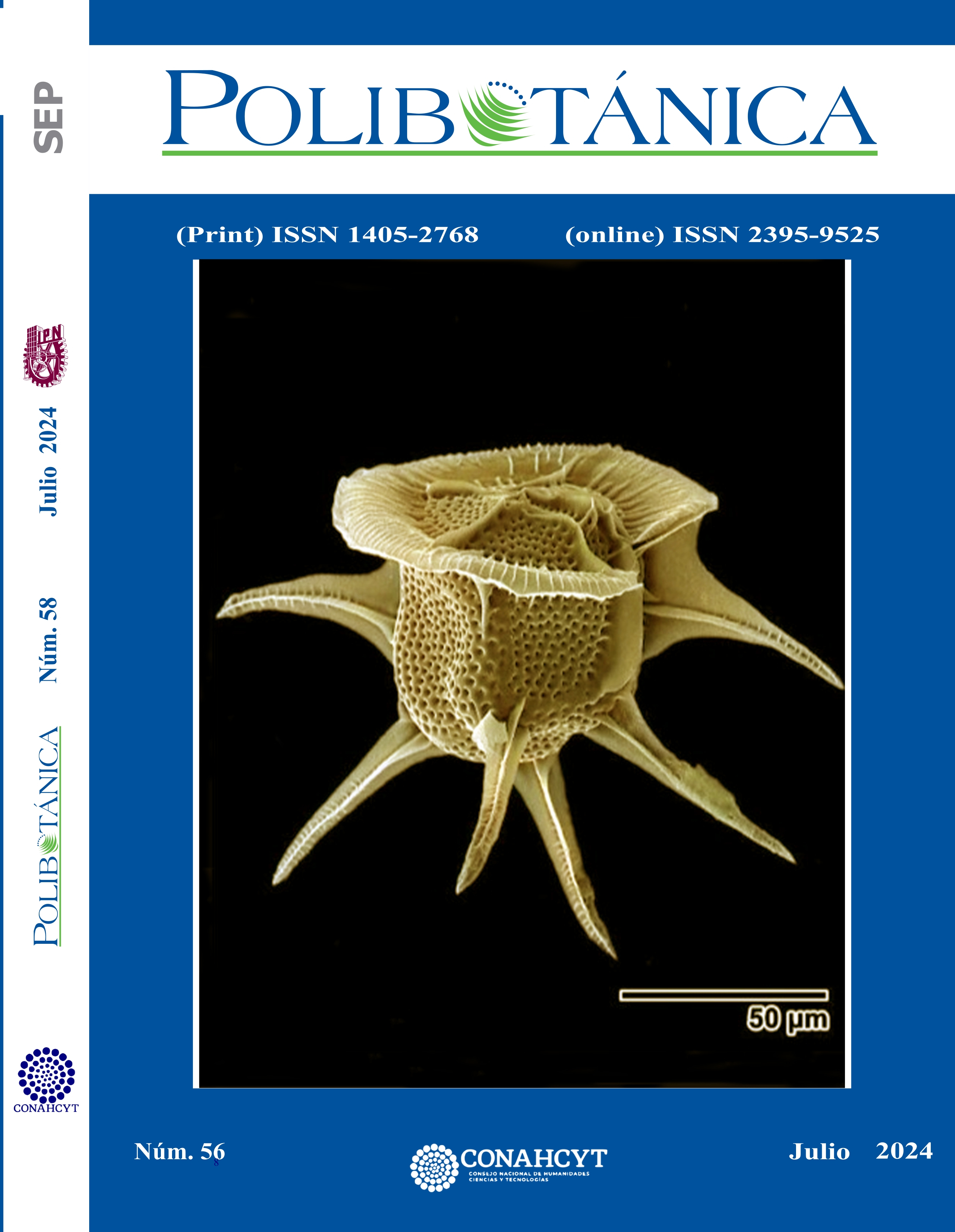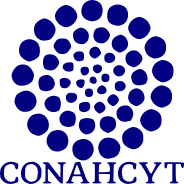Fibers and designs used in the production of amate paper in San Pablito, Pahuatlán, Puebla, Mexico
DOI:
https://doi.org/10.18387/polibotanica.58.17Keywords:
ñahñnus, handicrafts, secondary phloem, tropical trees, traditional knowledgeAbstract
Amate paper has been produced since pre-Hispanic times in various localities in Mesoamerica. From the 60s onwards, it has been. one of the best-selling crafts in Mexico, and some of the best-known artisans are the ñahñus of the community of San Pablito, Municipality of Pahuatlán in the Sierra Norte de Puebla. Much of the appeal of this craft comes from the unrefined character of the raw material, which is hand beaten pulp created from the secondary phloem of various species of tropical trees. Based on a bibliographic review, semi-structured interviews, and field observation, we documented the diversity of species that have been used to make amate paper and knowledge about these species by artisans from San Pablito, as well as amate paper making techniques and innovation in designs, from its emergence of the craft to the present day. The results indicate that historically 16 species have been used to make amate paper; currently, a pioneering tropical tree known in the Sierra Norte de Puebla as 'jonote' (Trema micrantha (L.) Blume) is the species most used. Regarding the artisans´ knowledge about the plant species used, of the 16 documented for the manufacture of amate paper, currently artisans know 12 species, four of which are only known by 1% of the interviewees. On the other hand, the diversity of designs has remained high, as creativity flourishes in the production of amate paper as a craft. In the last ten years the community has been energized by imagination and a sense of entrepreneurship, mainly by the young ñahñus. This work contributes to the study of traditional wisdom and practices and the ways in which they are transformed over time. In particular it contributes to understand the production processes of handicrafts in communities where during the last decades this activity has elaborated as it has become the main source of their income and maintenance.
References
Alexiades, M. (2003). Ethnobotany in the Third Millennium: expectations and unresolved issues. Delpinoa, 45, 15-28.
Alexiades, M. (2009). The cultural economic globalisation of traditional environmental knowledge systems. En Heckler, Serena (ed). Landscape, Process and Power: Re-evaluating traditional environmental knowledge. Oxford and New York, Berghahn. https://www.berghahnbooks.com/title/HecklerLandscape
Arroyo, O. (1993). El Papel de amate. Artesanías de América, 41(42), 268-285. http://documentacion.cidap.gob.ec:8080/handle/cidap/872
Barbosa Sánchez, A.P. (2005). Artesanías indígenas mexicanas: funciones económicas y culturales. Cuadernos Americanos, 113, 191-211. https://rilzea.cialc.unam.mx/jspui/bitstream/CIALC-UNAM/A_CA555/2/CA113_191_211.pdf
Carrasco, P. (1979). Los Otomíes. Cultura e Historia Prehispánica de los Pueblos Mesoamericanos de Habla Otomiana. Toluca, México: Biblioteca Enciclopédica del Estado de México. https://historicas.unam.mx/publicaciones/publicadigital/libros/015/otomies_cultura.html
Christensen, B. (1942). Notas sobre la fabricación del papel indígena y su empleo para “brujerías” en la Sierra Norte de Puebla, México. Revista Mexicana de Estudios Antropológicos, Sociedad Mexicana de Antropología, 6(1-2), 109-124.
Christensen, B. (1963). Bark paper and witchcraft in Indian México. Economic Botany, 17, 360-367. https://link.springer.com/article/10.1007/BF02860145
Cocks, M.L. (2006). Biocultural diversity: moving beyond the realm of ‘indigenous’ and ‘local’ people. Human Ecology, 34(2), 185-200. https://link.springer.com/article/10.1007/s10745-006-9013-5
Cruz, M, M., López Binnqüist, C. y Neyra, L. (compiladoras) (2009). Artesanías y Medio Ambiente. Comisión Nacional para el Conocimiento y Uso de la Biodiversidad Conabio / Fondo Nacional para el Fomento de las Artesanías FONART, México. https://www.biodiversidad.gob.mx/publicaciones/librosDig/pdf/ArtesaniayMedioAmb.pdf
D´Aubeterre, M. E., Rivermar M.L y Fagetti, A. (2013). Producción de papel amate y migración a estados unidos: los otomíes de san pablito pahuatlán, puebla, méxico. Iberoamerica, 15(1), 271-312.
Ellis, F. (1998). Household strategies and rural livelihood diversification. The Journal of Development Studies, 35(1), 1-38.
Fagetti, A., Rivermar, M. L. y D´Aubeterre, M. E. (2012). Migración transnacional y medicina tradicional. Otomíes de San Pablito Pahuatlán, Puebla en Carolina del Norte. Anales de Antropología, 46, 203-224. https://www.revistas.unam.mx/index.php/antropologia/article/view/30947
Galinier, J. (1987). Pueblos de la Sierra Madre. Etnografía de la comunidad Otomí. Colección Clásicos de la Antropología 17. Instituto Nacional Indigenista INI / Centro Francés de Estudios Mexicanos y Centroamericanos CEMCA, México.
Gormsen, E. (1991). Artesanía, turismo e identidad regional en México. Trace 20: 29-40.
Lenz, H. (1950). El papel y sus supersticiones. Artes de México. Mitos, Ritos y Hechicerías, 124(16), 84-92.
López Binnqüist, C. (2003). The endurance of Mexican Amate Paper: Exploring Additional Dimensions to the Sustainable Development Concept. Tesis de Doctorado. Twente University, Países Bajos. https://ris.utwente.nl/ws/portalfiles/portal/279526376/thesis_Lopez_Binnquist.pdf
López Binnqüist, C. (2010). El diseño artesanal y su relación con los recursos naturales empleados como materia prima: el caso del papel amate elaborado por los ñahñús de la sierra norte de Puebla. Memorias del IV Coloquio Nacional de Arte Popular. El Diseño Artesanal: Perspectivas y Situación Actual. Consejo Veracruzano de Arte Popular COVAP. Veracruz, México.
López Binnqüist, C., Quintanar–Isaías, A. y Vander Meeren, M. (2012). Mexican bark paper: Evidence of history of tree species used and their fiber characteristics. Economic Botany, 66, 138-148. https://link.springer.com/article/10.1007/s12231-012-9196-1
Martin, G.J. (2004). Ethnobotany: a methods manual. People and Plants, Conservation Series. Earthscan Publications, Reino Unido.
Martínez, M. A., Evangelista, V., Basurto, F., Mendoza, M. y Cruz-Rivas, A. (2007). Flora útil de los cafetales en la Sierra Nortes de Puebla, México. Revista Mexicana de Biodiversidad, 78, 15-40. https://revista.ib.unam.mx/index.php/bio/article/view/457/1928
Neyra González, J.L. (2013). Análisis y perspectivas de la marca colectiva “Artesanía de papel amate P’ete-I San Pablito Pahuatlán”: hacia una producción sustentable. Tesis de Maestría. Universidad Iberoamericana Puebla. México.
Peters, C. M., Rosenthal, J. y Urbina, T. (1987). Otomi bark paper in Mexico: commercialization of a pre-hispanic technology. Economic Botany, 41(3), 423-432. https://link.springer.com/article/10.1007/BF02859061
Ramos Maza, T. R. (2004). Artesanas y artesanías: indígenas y mestizas de Chiapas construyendo espacios de cambio. Liminar. Estudios sociales y humanísticos, 2(1), 50-71. https://liminar.cesmeca.mx/index.php/r1/article/view/143/127
Rebolledo-Morales, A. (2012). Estado actual del conocimiento tradicional sobre los recursos biológicos empleados en la producción de papel amate en la comunidad de San Pablito, Pahuatlán, Puebla. Tesis de Maestría. Centro de Investigaciones Tropicales, Universidad Veracruzana. México. https://cdigital.uv.mx/handle/123456789/46383
Rivermar, M. L. (2012). En un porvenir incierto. La transición de la adultez entre jóvenes de un municipio de la Sierra Norte de Puebla, México. Norteamérica, 7(1), 99-124. https://www.revistanorteamerica.unam.mx/index.php/nam/article/view/159
Rojas Serrano, C., Martínez Corona, B., Ocampo Fletes, I. y Cruz Rodríguez, J. A. (2010). Artesanas mixtecas, estrategias de reproducción y cambio. La ventana. Revista de estudios de género, 4(31), 101-138. http://revistalaventana.cucsh.udg.mx/index.php/LV/article/view/950
Sandstrom, A.R. y Sandstrom, P.E. (1986). Traditional papermarking and paper cult figures of Mexico. University of Oklahoma Press: Norman, Estados Unidos. https://ia600301.us.archive.org/16/items/traditionalpape00sand/traditionalpape00sand.pdf
Soto, S. A. (1962). Sobre la significación etnográfica de la Sierra de Puebla, (Viaje a Pahuatlán, mayo de 1962), México, INAH/CAPFCE-SEP
Standley, P. C. (1923). Trees and shrubs of Mexico (Oxalidaceae-Turneraceae). Contributions from the United States National Herbarium. Vol 23. Smithsonian Institution / United States National Museum, Washington, DC, Estados Unidos. https://www.biodiversitylibrary.org/item/53162#page/84/mode/1up
Toledo, V.M. y Barrera-Bassols, N. (2008). La memoria biocultural: La importancia ecológica de las sabidurías tradicionales. Icaria editorial. Barcelona, España.
Toledo, V.M., Barrera-Bassols, N. y Alarcón-Charles, P. 2018. Etnoecología Mesoamericana. Antología de publicaciones 1980-2018. Red Temática sobre Patrimonio Biocultural / Universidad Nacional Autónoma de México. https://patrimoniobiocultural.com/producto/etnoecologia-mesoamericana/
Turok, M. (2006). Medio ambiente y produccion artesanal: contexto y experiencias. Memoria del III Coloquio Nacional. Consejo Veracruzano de Arte Popular. El Arte Popular Mexicano. Consejo Veracruzano de Arte Popular COVAP. Veracruz, México.
Vander Mereen, M. (1995). El Papel Amate: Tecnología, Composición y Alteraciones. Imprimatura, Revista de Restauración, 9, 3-12.
Downloads
Published
Issue
Section
License

Polibotánica by Departamento de Botánica de la Escuela Nacional de Ciencias Biológicas del Instituto Politécnico Nacional se distribuye bajo una Licencia Creative Commons Atribución-NoComercial-CompartirIgual 4.0 Internacional.




















